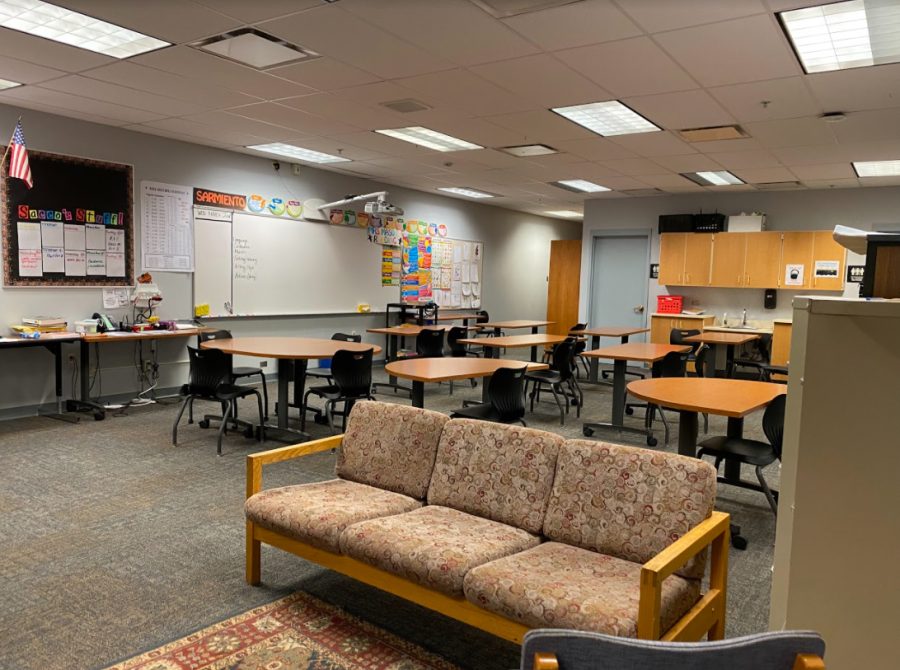Stress, worry, and work will never come to an end. There’s always something just around the corner to keep your mind busy.
Like students, teachers are prone to burnouts as well and can often be overlooked. There are many resources provided for them at school that can help them such as: social workers, the Getaway, the lounges in the library, and the instructional coaches.
But some of those resources are not just for teachers.
In its last article, X-ray’s co-Editor-in-chief Katie Kempff has covered the school board meeting on November 8 and the burnout that teachers have faced during this school year.
So what can teachers do to help ease the stress?
Having a place to take a break is one way to help teachers to rest and recharge. Especially with 200+ staff members in the school, it’s good to find a place for them to take their breaks in. This is an approach that other schools across the country have initiated.
As of now, there are two staff lounges. There is a staff lunchroom next to the mailroom and another workroom upstairs next to the library. Sometimes these spaces are not available or they are overcrowded (especially during Covid).
Principal Richter said that it is important for teachers to find “that quiet place where they know they can be uninterrupted which helps to decompress, center themselves or prepare for their next class.” However, with the large number of students attending school, it has been difficult to find more free space for staff.
Several years ago, there was a larger teachers’ lounge upstairs, adjacent to the LRC, which provided them with two staff-only bathrooms, a microwave and a sink. There was also room for a coffee maker or two.
However, that space was turned into a classroom to accommodate the growing student population.
The current “teacher workroom” is next to the LRC, but has only one copier, a lot less space, and no facilities. The space is about 25% smaller than the previous teacher workroom and must accommodate more staff as well.
Laura Smith, an English teacher who has worked 28 years at East, said that “there’s always a line of people [at the bathrooms] so going during a passing period is impossible” compared to when they used to have the old workroom.
The office spaces for the departments can provide a sort of break space for teachers. However, there’s a lack of privacy due to desks being right next to each other, and in most offices, they are very close to each other. It’s great for collaboration between teachers, but not for personal time.
Currently, the student population has dropped from about 2,500-2,550 down to 2,000-2050 students. Principal Richter has met up with the firm for building utilization in the district and has explained to them how teachers don’t have a lot of space available for them.
He believes that “our teaching staff [needs] to be able to have space that they need to conduct the work they feel they need to do.”
But it will take more than a year for plans to happen with how long the process will take. With space like that, it would take more than a year for planning with the bids, permitting, and permission alone through the city, county, and Regional Office of Education. There’s a lot of different factors that play into it. Unfortunately providing more space for teachers will not come right away.
Another way is to increase break time for teachers. Most teachers only have a 45 minute break period which includes lunch, personal time, day planning and grading.
Smith said, “Teachers who have to supervise a lunch study have two prep periods, five periods to teach, lunch study period, called supervision (each have a period of supervising 20 minutes breaks). And 20 minutes to eat lunch and run to the other end of the building to catch their next class.”
It is not only a hassle for teachers, but also a time crunch that can trigger stress. With lack of time, there’s not enough moments of the day where teachers can catch their breath and give themselves a longer break.
Increasing the time for breaks can allow teachers to use destressing methods in order to balance out their work. By doing so, it will decrease the amount of burnout teachers will potentially experience. Not only will that give teachers more freedom of their break time rather than having them choose between work or personal time. Because in the end, there won’t be enough time for both.
The final way is having social emotional services provided to them in school. Having a professional to talk to when needed is nice to have around especially when stress starts to build up.
As Richter added, like most staff they’ll be able to be “that critical friend to just be able to kind of bounce some things off of or just listen,” however, “sometimes things might surpass my skill set and I’m not always able to necessarily help because again, I’m not trained in that.”
But on a district level, Richter added, “Our district does offer through our medical program something called the employee assistance program, ERP,… you can get up to three free sessions with somebody, fully covered through insurance.”
Finding some way to talk to professionals when needed can give teachers the chance to recollect themselves moving forward. .
Students can also be part of the solution.
Emily McHenry, Senior Parliamentarian of Student Council, described the “Care Packages” they hand out to teachers monthly.
They are “little treats for the teachers” in a color scheme. Normally they put in “chips and pens, [they’re] just little gifts for the teachers to show our appreciation in those colors (last month pink and red).” Through this, they hope to help make their day a little brighter.
Categories:
Many are searching for ways to reduce teacher burnout
Chloe Ladines, Editor-in-Chief
April 5, 2022
This classroom, now a specialized reading classroom, was once the Teacher Workroom. It is in the B200s area and has access to the LRC.
More to Discover
About the Contributor

Chloe Ladines, Editor-in-Chief
Chloe is now in her fourth year on the X-ray staff. She likes to write news stories. She also likes to draw. She was planning to compete in the editorial cartoon and advertising events at Sectionals this year, but our IHSA competition season was cancelled due to Covid-19. She competed in 2021 and qualified for state. She was the graphics editor for the 2020-2021 year. Now she is co-editor-in-chief.








